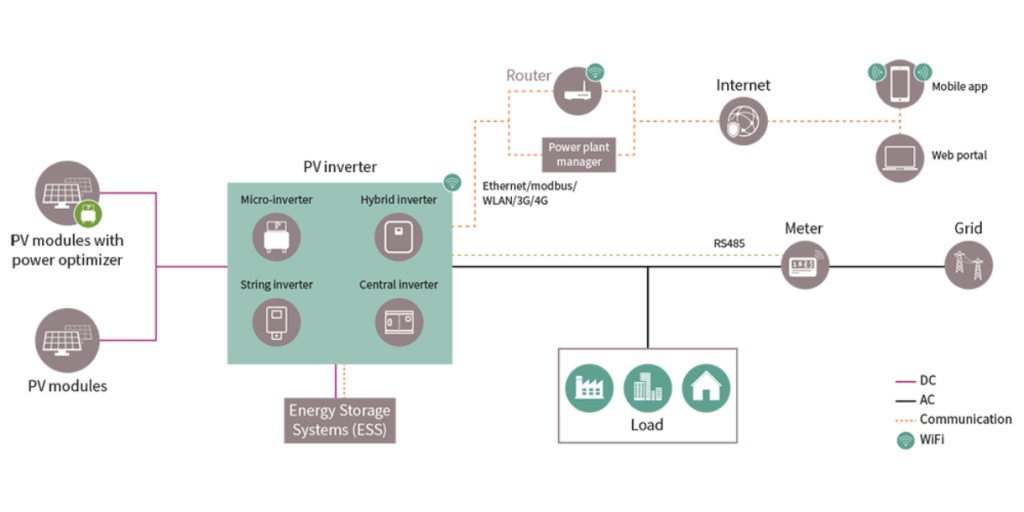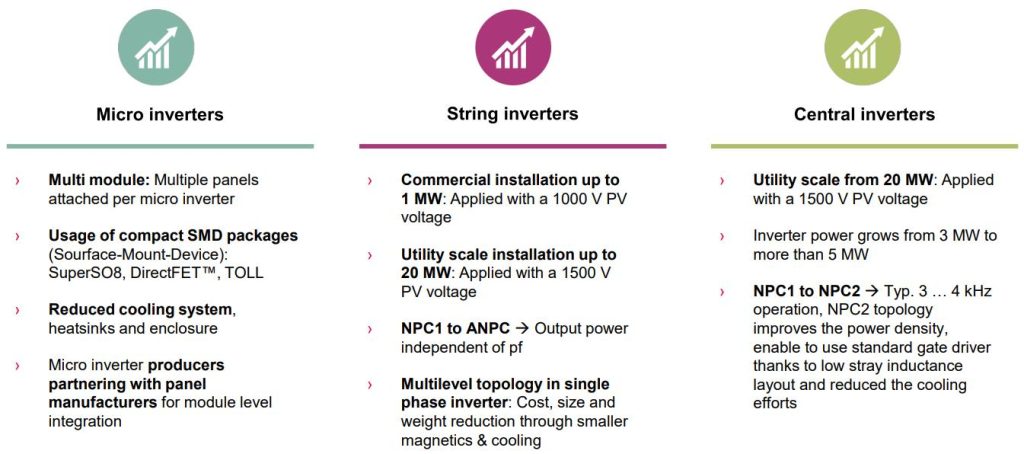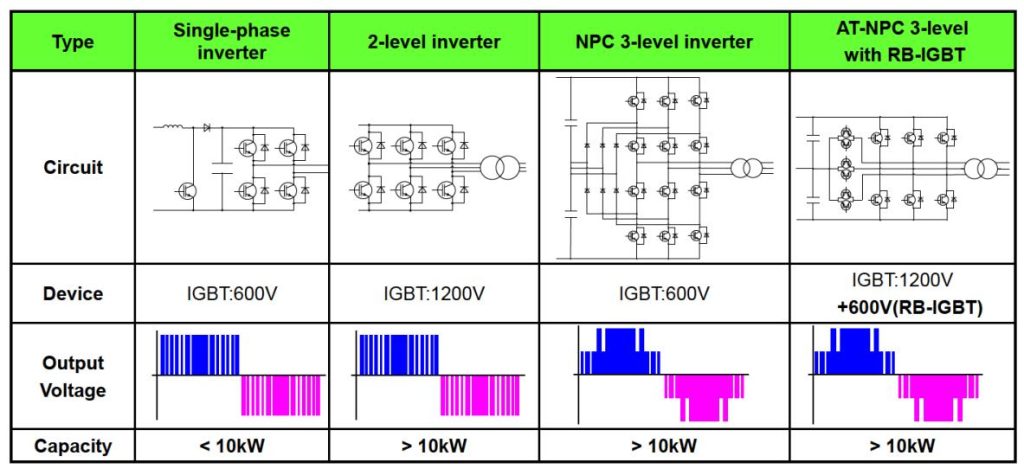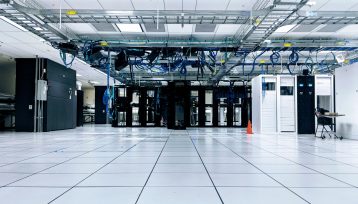Solar power is the conversion of renewable energy from sunlight into electricity, either directly using photovoltaics (PV), indirectly using concentrated solar power, or a combination. Concentrated solar power systems use lenses or mirrors and solar tracking systems to focus a large area of sunlight into a small beam. Photovoltaic cells convert light into an electric current using the photovoltaic effect.
Photovoltaics were initially solely used as a source of electricity for small and medium-sized applications, from the calculator powered by a single solar cell to remote homes powered by an off-grid rooftop PV system. Commercial concentrated solar power plants were first developed in the 1980s. Since then, as the cost of solar electricity has fallen, grid-connected solar PV systems have grown more or less exponentially. Millions of installations and gigawatt-scale photovoltaic power stations have been and are being built. Solar PV has rapidly become an inexpensive, low-carbon technology.
- Renewable, clean and ecologically harmless energy source
- Produces no noise, harmful emissions or polluting gases
- Modular systems can be quickly installed anywhere
- Installation cost is negligible in new building realization
- In the building, it is possible to cover the external surfaces (roof, walls)
- Energy is produced close to the load: no energy lost on the distribution line
- Minimal maintenance is required to keep the system running
History of Solar Power Conversion
A solar cell, or photovoltaic cell (PV), is a device that converts light into electric current using the photovoltaic effect. The first solar cell was constructed by Charles Fritts in the 1880s. The German industrialist Ernst Werner von Siemens was among those who recognized the importance of this discovery. In 1931, the German engineer Bruno Lange developed a photo cell using silver selenide in place of copper oxide, although the prototype selenium cells converted less than 1% of incident light into electricity.
Following the work of Russell Ohl in the 1940s, researchers Gerald Pearson, Calvin Fuller and Daryl Chapin created the silicon solar cell in 1954. In 1957, Mohamed M. Atalla developed the process of silicon surface passivation by thermal oxidation at Bell Labs. The surface passivation process has since been critical to solar cell efficiency.
In the early 1970s, technological developments from American Dr. Elliot Berman significantly lowered solar costs. The Exxon Corporation funded the research that led to this milestone, and the resulting solar panel was more efficient and less expensive than its predecessors, allowing commercial viability for solar technology and leading to a turning point in the adoption of solar energy.
The 1970s saw a global solar energy turning point as well, as the world reeled from the tumultuous repercussions of the Arab oil embargo. As oil prices quadrupled and lines formed around the blocks of gas stations throughout the country, it became apparent that the world had need of a more diverse energy system. In 1977, the US embraced the development of solar energy by creating the Solar Energy Research Institute. Other countries worldwide followed suit in the creation of their own solar-dedicated institutions. In 1978 the first iteration of a Feed-In-Tariff was implemented when President Jimmy Carter signed the National Energy Act (NEA) to encourage energy efficiency and the continued development of renewables.
The 1970s through the 1990s saw slow but steady adoption of solar energy, as solar manufacturers continued making solar cells smaller and less expensive. This continued pace of development is dotted with specific feats of engineering that brought notoriety and further technological development to the field. In 1981, Paul Macready built the first solar powered aircraft. Powered by over 1,600 solar cells, the plane flew from France to England. In 1982, the first solar powered cars were developed in Germany, continuing the trend of solar-powered transportation.
Throughout this time period, developers were building increasingly large solar energy plants, establishing solar as more than just a niche energy source. Solar was becoming mainstream.
Since the late 2000s solar has taken off to become a national phenomenon and a credible and reliable energy source. Solar has taken ahold of the world. New financing options, increased efficiency, progressive policies, proven results, and a true and growing belief in this energy technology will keep growing, and will keep contributing to history as it does.
Photovoltaic Power Systems
The array of a photovoltaic power system, or PV system, produces direct current (DC) power which fluctuates with the sunlight’s intensity. For practical use this usually requires conversion to certain desired voltages or alternating current (AC), through the use of inverters. Multiple solar cells are connected inside modules. Modules are wired together to form arrays, then tied to an inverter, which produces power at the desired voltage, and for AC, the desired frequency/phase.
Many residential PV systems are connected to the grid wherever available, especially in developed countries with large markets. In these grid-connected PV systems, use of energy storage is optional. In certain applications such as satellites, lighthouses, or in developing countries, batteries or additional power generators are often added as back-ups. Such stand-alone power systems permit operations at night and at other times of limited sunlight.
Combining solar panels with energy storage systems is one effective way of synchronizing supply and demand. Efficient and reliable power semiconductors and inverter technologies are required to convert DC to AC and transmit the power with minimal losses.
In solar plants, the availability of the inverter is a key criterion for ensuring economic operation. It is equally important that the voltage supplied is of high line quality in order to meet the energy suppliers’ requirements. A major selling point for inverters in stiff competition is high efficiency; ultimately, the energy from the solar panel must be fed into the grid with the minimum possible losses. The best solar inverters achieve an efficiency of more than 98%.
The basic structure of a solar inverter without transformer, with the function groups: boost converter/MPP tracker, DC bus voltage and inverter.
DC/DC Boost Converter
The DC/DC boost converter scales up the output voltage of the solar panel to the level of the DC link voltage. Depending on the incidence of light on the solar cells, the MPP tracker (Maximum Power Point) controls the operating point in such a way that the product of output current and output voltage is the maximum possible (highest efficiency). The DC link voltage is converted by an inverter with IGBTs or power MOSFETs into AC voltage, and is then fed, as single- or three-phase, into the low-voltage mains system, or, via a transformer, into the medium-voltage system.
PV systems for island operation with stand-alone inverters are not coupled to the energy grid and work independently or are synchronized with other power generators, such as diesel generators or wind power plants and energy storage units.
System designs using hybrid inverters are currently gaining in importance. These have battery storage connected to the DC link via a DC/DC converter. This allows for “private consumption”, i.e., it is not compulsory for excess energy produced to be recovered by the utility companies, and systems with very high output can also contribute to support the grid. Depending on the solar panel area, output, light conditions and application, solar cells and solar inverters are interconnected differently, resulting in different inverter structures.
Module Inverter
A single-phase inverter with low output is connected to each individual solar module. This model is used for sub-arrays with extremely varied orientation and shading, such as on vehicles.
String Inverter
Single-phase inverter with MPP tracker for typical outputs ranging from 0.5 kW to 5 kW for a string of solar panels connected in series. These are widely used in rooftop photovoltaic systems on private dwellings. Many different, occasionally specialized topologies are used here.
Central Inverter
Relatively large three-phase inverter system (switchgear cabinet) with outputs ranging from 60 kW to 1 MW, with several MPP trackers for larger solar farms.
Multistring Inverter
Single- or three-phase inverter with several MPP trackers for multiple strings of interconnected solar panels. Multistring inverters are used in medium sized rooftop or ground-based systems, for example. The three-phase inverters are available for typical outputs of between 3 kW and 30 kW.
Major Players in Solar Power
The world’s total installed solar PV power capacity increased by 22% to 773.2 GW by the end of 2020, up from 635 GW in 2019 (see Fig. 10). Cumulative solar power has grown almost 500 times since the start of the millennium, when the grid-connected solar era basically began with the launch of Germany’s feed-in tariff law. Comparing the decade just gone by with the one before that, the global deployed on-grid PV capacity has grown an astonishing 1,860% – from 41.5 GW in 2010.
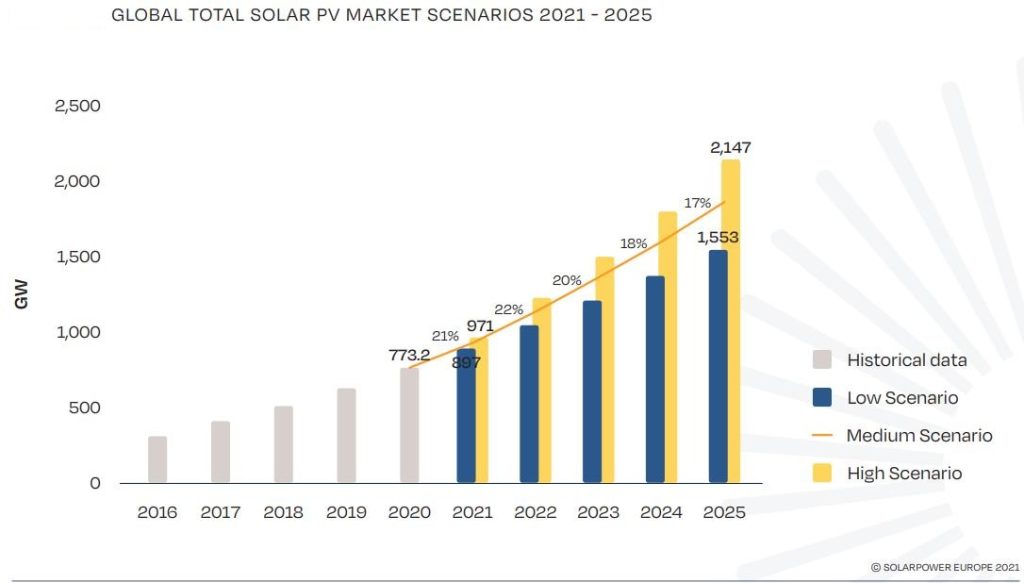
The next four years will be a very good period for solar power around the world. For each of these years, SolarPower Europe has considerably increased their forecasts, but next year, 2022, will stand out on various fronts. In their Medium Scenario, they see the global solar market adding 203 GW in 2022, the first time ever that annual PV installations will crack the 200 GW level. To put that into perspective, this would be only five years after the 100 GW level was reached, and two years earlier than our GMO 2020 forecasted (where 199.8 GW was predicted for 2024).
This would also mean a 25% growth rate over the 163 GW added in 2021, higher than for any other year in this 5-year market outlook. The final deployment volumes will depend on price developments in 2022 and H2/2021. If silicon, and in consequence, PV module prices do not decrease in Q3/2021, which is likely, there will not be a fourth quarter rush but more delays of projects to be finalized in 2022.
Below are the solar panel manufacturers with the highest shipment capacity in GW based on data from 2020.
- LONGi Solar (China, 14.7 GW)
- Tongwei Solar (China, 12.1 GW)
- JA Solar (China, 10.8 GW)
- Aiko Solar (China, 10.5 GW)
- Trina Solar (China, 9.0 GW)
- JinkoSolar (China, 8.7 GW)
- Canadian Solar (Canada, 8.3 GW)
- Zhongli (China, 7.4 GW)
- Suntech (China, 6.3 GW)
- First Solar (USA, 5.5 GW)
According to PV Magazine the ten largest inverter suppliers account for almost 80% of the global trade. Chinese manufacturer Huawei led the field with the top three manufacturers unchanged for five years. Chinese rival Sungrow had the second biggest slice of the market again, ahead of German outfit SMA. Spanish company Power Electronics claimed fourth position thanks to dominance in its domestic market. Italian inverter maker Fimer enjoyed the biggest growth, climbing to fifth after it took over the solar inverter business of Swiss company ABB.
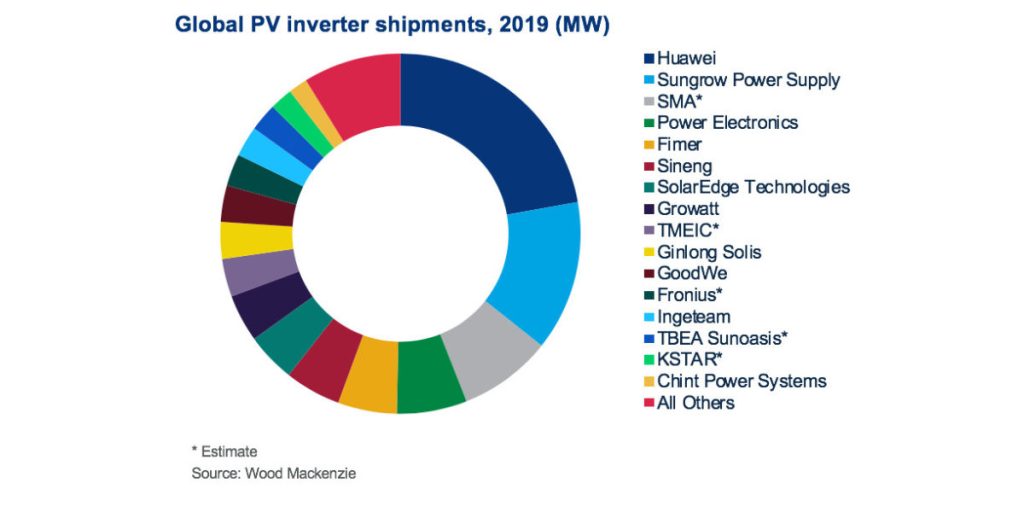
Power Semiconductors Used in Solar Power
The market for semiconductors used in photovoltaic (PV) inverters, which convert direct current (DC) to alternating current (AC) from the PV modules, will continue to expand in the long term.
One of the most important trends in the semiconductor industry today is the development of solutions that improve energy efficiency. In particular, semiconductors play a key role in PV Inverters, where major power savings can be accomplished.
The demand for high-quality energy conversion by PV inverters has increased the penetration of discrete and analog semiconductors. In fact, more than three quarters of PV-inverter semiconductor revenue is made up of analog and discrete components.
Small-scale PV inverters such as microinverters and single-phase inverters generally include metal-oxide-semiconductor field-effect transistors (MOSFETs) and other components, given their low power rating of less than 500 W. Large three-phase inverters with power ratings above 500 W generally drive the demand for high-power discrete semiconductors, such as insulated gate bipolar transistors (IGBTs), because of their better performance at high temperatures.
Today, the ongoing major trend in solar designs is the increase of power density based on a reduction of switching losses, enabling smaller heatsinks, and also allowing higher operating frequencies, enabling smaller magnetics. SiC diodes have increasingly become a staple component in modern solar string inverter solutions as well as in micro-inverter applications. Hybrid solutions are a standard part of today’s solar inverters all around the world.
In most cases inverters use power semiconductors such as MOSFETs and IGBTs based on silicon technology, but the need to optimize efficiency and increase power density requires raising the inverter switching frequency. This, in turn, requires the power switches to achieve low switching loss — a major problem for silicon power switches. GaN achieves ultra-low switching loss at high switching frequency and is therefore a superior choice for both system efficiency and power density. Renewable energy systems using GaN power transistors do not needlessly waste solar energy during the conversion process.
GaN is important to solar designs because of its ability to offer significantly improved performance while reducing the energy and the physical space needed to deliver that performance, when compared with conventional silicon.
If you need power semiconductors for your solar inverters I recommend you to take a look at my list of manufacturers of power semiconductors.
Find out more about power semiconductors applications in the special section of the website.
Learn more about power semiconductors in Power Semiconductors section of my Marketing Psycho blog. And if you are interested in power semiconductors market news, you can always subscribe to my Power Semiconductors Weekly updates.
Power Semiconductors Weekly is a Marketing Psycho weekly podcast covering the latest news from power semiconductors industry. Delivered to you every Tuesday by Alexey Cherkasov, Power Semiconductors Weekly brings you the most interesting events in the world of power semiconductors and power electronics. Subscribe to Power Semiconductors Weekly and watch it on YouTube every Tuesday.
If you prefer a monthly update about the world of power semiconductors delivered to your e-mail address, please, subscribe to Marketing Psycho Power Semiconductors newsletter.

